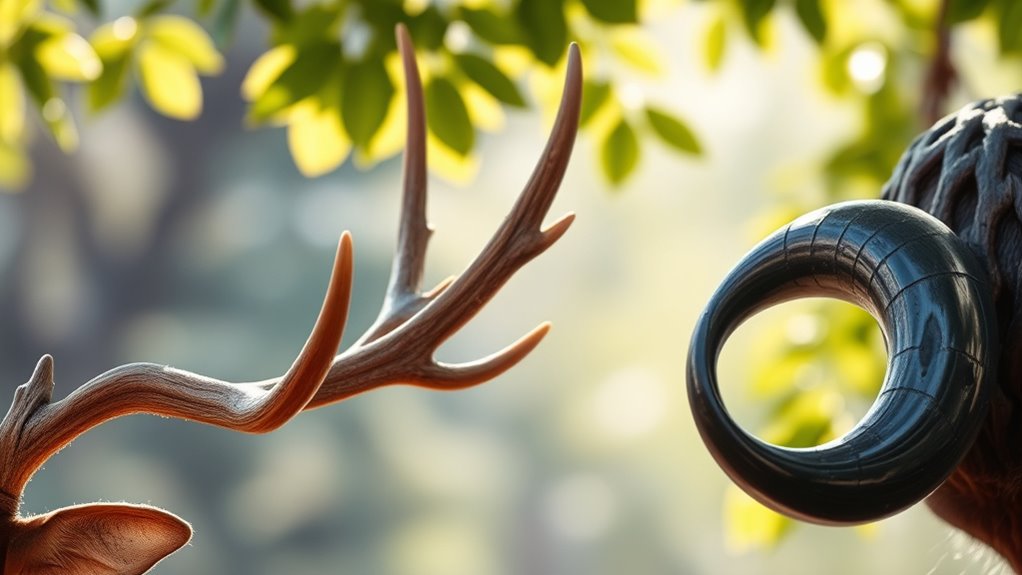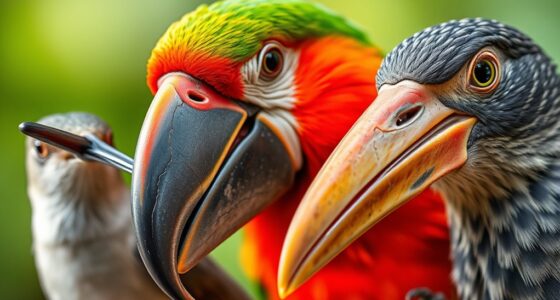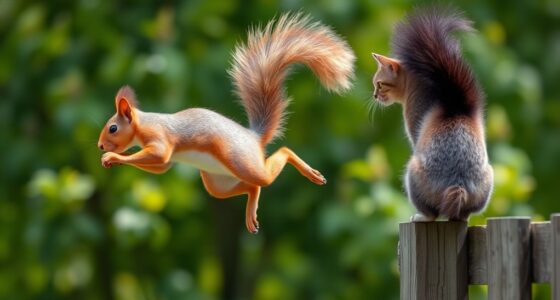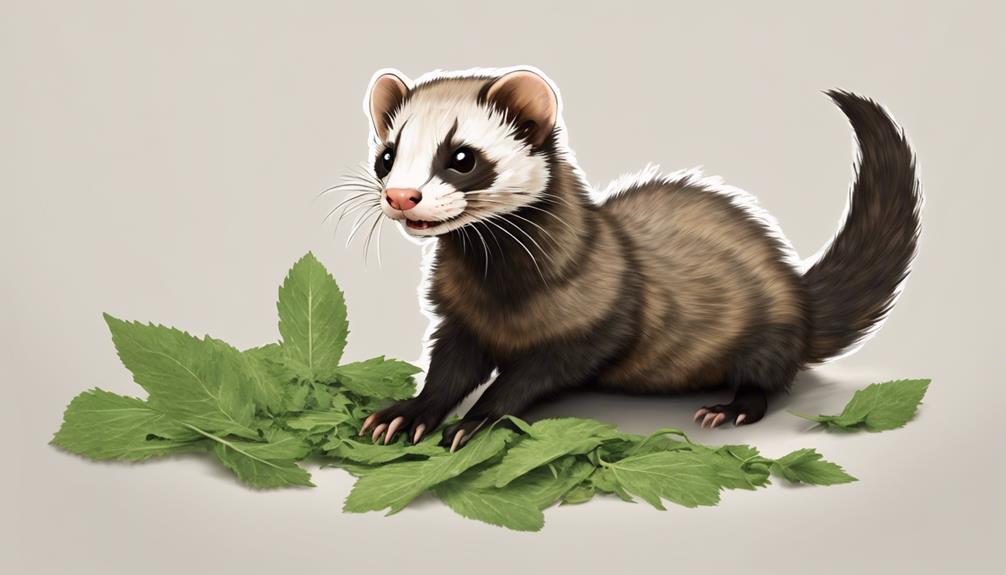Antlers and horns differ in structure and function. Antlers are made of bone, grow from the skull, and are shed annually, typically found in male deer. They’re covered in velvet during growth and are used mainly for competition and mating displays. In contrast, horns are permanent, have a bony core covered by keratin, and grow continuously, found in both sexes among different species. Understanding these distinctions reveals more about animal behavior and adaptation.
Key Takeaways
- Antlers are made of bone and are shed annually, while horns have a bony core and grow continuously without shedding.
- Antlers grow covered in velvet during the spring and summer, whereas horns do not have a velvet covering at any stage.
- Antlers are primarily found in male deer species and are used for mating displays, while horns can be found in both sexes of various species for defense.
- Antlers serve primarily competitive and reproductive functions, while horns provide protection and help establish social hierarchy among animals.
- The structure and growth cycle of antlers are linked to seasonal changes, unlike the constant growth of horns throughout an animal’s life.
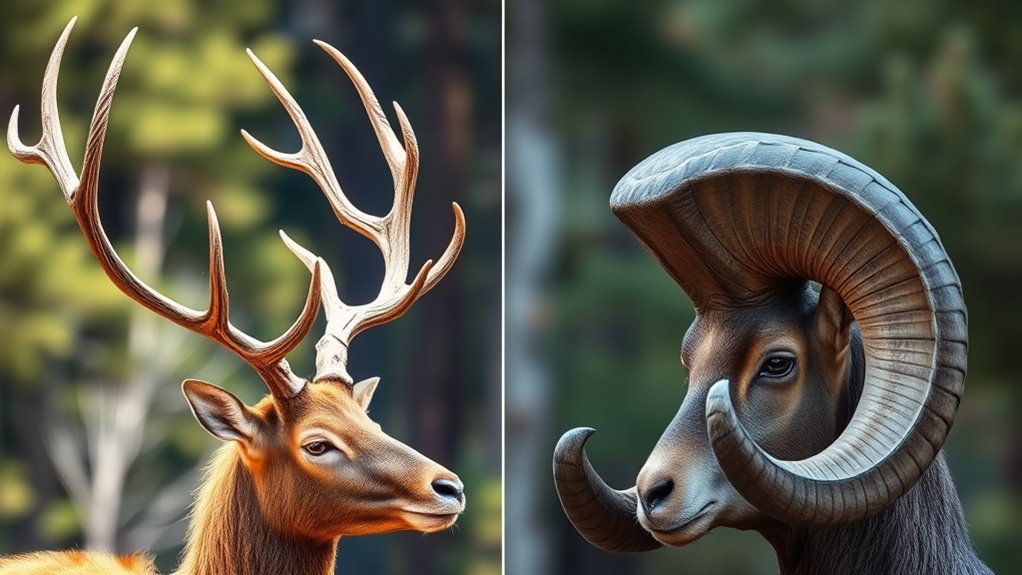
When you think of antlers and horns, you might assume they’re the same, but they’re actually quite different. Antlers are a unique feature found primarily in male members of the Cervidae family, like deer and elk. They grow from the skull and are made of bone, shedding and regrowing each year in a cyclical pattern. Horns, on the other hand, are found in various species, including cattle and goats. They consist of a bony core covered by a sheath of keratin, and unlike antlers, they don’t shed. Understanding these differences can help you appreciate the fascinating growth patterns and behavior differences associated with each.
Antlers typically grow during the spring and summer months, fueled by hormones and nutrients. As they develop, they’re covered in a soft, velvety layer that provides blood supply. Once the antlers reach their full size, the velvet dries and falls off, revealing the hard bone beneath. After the mating season, usually in late winter, males shed their antlers, making way for new growth in the following cycle. This seasonal pattern plays a significant role in their reproductive behavior. During the rut, males use their antlers to establish dominance and attract females, engaging in impressive displays and sparring with other males. Interestingly, the seasonal shedding of antlers can be compared to the way some fruits, like citrus, have specific harvest periods based on their growth cycles.
Horns grow continuously throughout an animal’s life and don’t follow the same seasonal cycle. You’ll notice that horns can vary greatly in shape and size, depending on the species. They’re often used as a defense mechanism and can be essential for survival in the wild. For example, male sheep use their horns in head-butting contests to establish hierarchy within their groups. The behavior differences between horned and antlered animals reflect their evolutionary adaptations and social structures, with horns often being a tool for protection and antlers serving as a means for male competition.
Frequently Asked Questions
What Animals Have Antlers Versus Those With Horns?
You’ll find antlers mainly in male deer, elk, and moose, showcasing sexual dimorphism as they’re used in mating displays and fights for dominance. On the other hand, animals like goats, sheep, and cattle have horns, which are present in both sexes and serve an evolutionary function for defense and territory. Understanding these differences highlights how various species adapt to their environments while maximizing reproductive success.
Can Antlers and Horns Regenerate After Being Lost?
Antlers regenerate like a tree shedding its leaves each year. When male deer lose their antlers, they undergo a remarkable regeneration process. This seasonal growth starts in spring and can take several months. Unlike antlers, horns don’t regrow if lost; they’re permanent. So, while you can marvel at a deer’s fresh antlers each year, remember that horns are a lifelong fixture for animals like cows and goats.
Do Antlers and Horns Serve the Same Purpose?
Antlers and horns don’t serve the same purpose. You’ll find antlers are primarily decorative, showcasing dominance during mating seasons, while horns are functional, providing protection and defense year-round. This difference highlights their evolutionary significance; antlers grow and shed annually, reflecting seasonal changes, while horns remain attached for life. So, when you observe these structures, remember they play distinct roles in the survival and reproduction strategies of their respective species.
How Do Antlers and Horns Affect Animal Behavior?
Antlers and horns substantially influence animal behavior. Did you know that about 80% of male deer shed their antlers annually? This shedding triggers changes in social dynamics, as the absence of antlers alters dominance hierarchies. In contrast, animals with horns, like goats, engage in horn grooming, which reinforces social bonds. Both features play essential roles in mating displays and territorial disputes, shaping interactions within species and their environments.
Are Antlers and Horns Made of the Same Material?
Antlers and horns aren’t made of the same material. Antlers, which you’ll find on deer, are composed of bone and grow in distinct patterns each year. On the other hand, horns, like those of cattle, are made of keratin, the same protein as hair and nails, and show various coloration variations. While antlers are shed annually, horns persist throughout an animal’s life, showcasing how these structures differ in both composition and function.
Conclusion
So, next time you spot a deer flaunting its antlers or a goat strutting its horns, remember: one’s a temporary fashion statement, while the other’s a lifelong accessory. Antlers are like that trendy hat you wear for a season, while horns are more like the trusty boots that never go out of style. In the animal kingdom, it seems, everyone’s got their own vibe—whether it’s a flashy shed or a steadfast set of horns, you do you!
